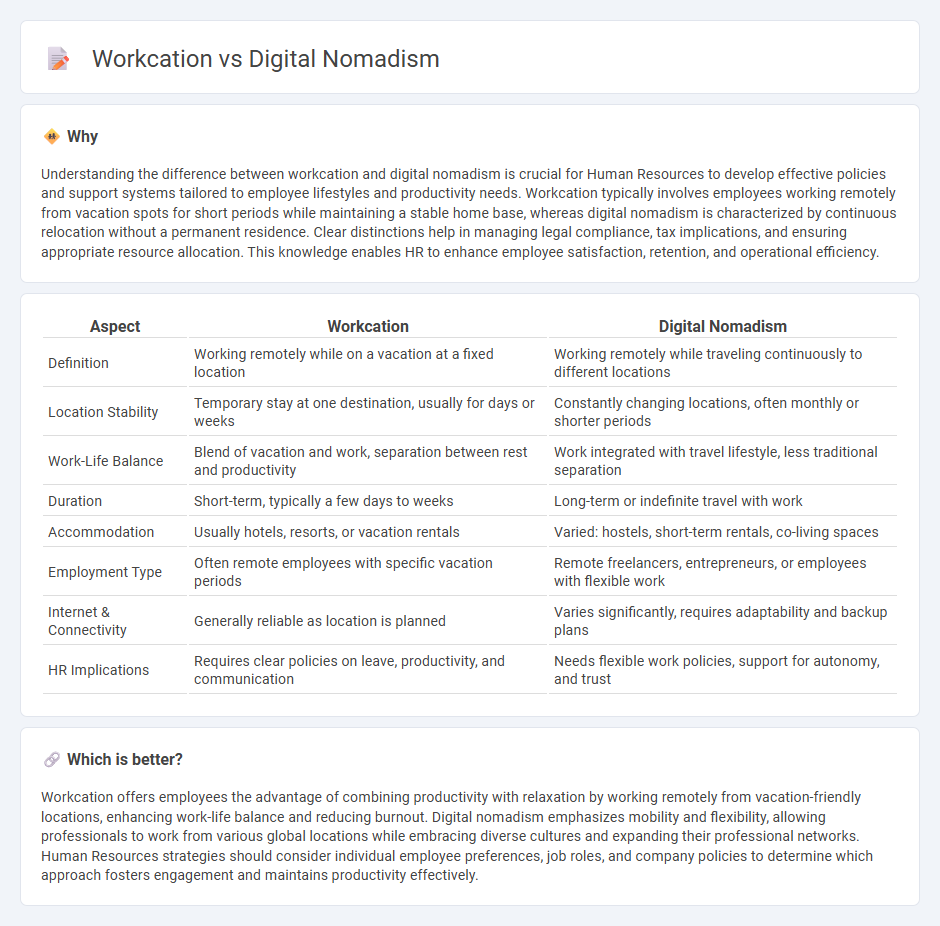
Workcation combines remote work with leisure by allowing employees to work from vacation destinations, promoting work-life balance and boosting productivity. Digital nomadism involves sustained travel while working remotely, often with no fixed base, highlighting flexibility and location independence. Explore how these evolving human resources trends redefine modern work culture and employee engagement.
Why it is important
Understanding the difference between workcation and digital nomadism is crucial for Human Resources to develop effective policies and support systems tailored to employee lifestyles and productivity needs. Workcation typically involves employees working remotely from vacation spots for short periods while maintaining a stable home base, whereas digital nomadism is characterized by continuous relocation without a permanent residence. Clear distinctions help in managing legal compliance, tax implications, and ensuring appropriate resource allocation. This knowledge enables HR to enhance employee satisfaction, retention, and operational efficiency.
Comparison Table
| Aspect | Workcation | Digital Nomadism |
|---|---|---|
| Definition | Working remotely while on a vacation at a fixed location | Working remotely while traveling continuously to different locations |
| Location Stability | Temporary stay at one destination, usually for days or weeks | Constantly changing locations, often monthly or shorter periods |
| Work-Life Balance | Blend of vacation and work, separation between rest and productivity | Work integrated with travel lifestyle, less traditional separation |
| Duration | Short-term, typically a few days to weeks | Long-term or indefinite travel with work |
| Accommodation | Usually hotels, resorts, or vacation rentals | Varied: hostels, short-term rentals, co-living spaces |
| Employment Type | Often remote employees with specific vacation periods | Remote freelancers, entrepreneurs, or employees with flexible work |
| Internet & Connectivity | Generally reliable as location is planned | Varies significantly, requires adaptability and backup plans |
| HR Implications | Requires clear policies on leave, productivity, and communication | Needs flexible work policies, support for autonomy, and trust |
Which is better?
Workcation offers employees the advantage of combining productivity with relaxation by working remotely from vacation-friendly locations, enhancing work-life balance and reducing burnout. Digital nomadism emphasizes mobility and flexibility, allowing professionals to work from various global locations while embracing diverse cultures and expanding their professional networks. Human Resources strategies should consider individual employee preferences, job roles, and company policies to determine which approach fosters engagement and maintains productivity effectively.
Connection
Workcation and digital nomadism both revolve around the integration of remote work with travel, enabling employees to maintain productivity outside traditional office environments. Human resources departments are increasingly adopting flexible policies to support these trends, enhancing employee satisfaction and retention by promoting work-life balance. Emphasizing technology such as VPNs and collaboration tools ensures seamless connectivity and security for remote workers engaging in workcation or digital nomadism lifestyles.
Key Terms
Remote Work Policy
Digital nomadism involves employees working remotely from various global locations, emphasizing flexibility and mobility, while workcation combines work with vacation by staying at one destination temporarily, blending productivity with leisure. A comprehensive remote work policy should define eligibility, communication protocols, cybersecurity measures, and time zone considerations to accommodate these models effectively. Explore our detailed guide to optimize your organization's remote work strategy for both digital nomads and workcationers.
Employee Benefits
Digital nomadism offers employees flexibility to work from diverse global locations, enhancing work-life balance and cultural exposure, which can boost creativity and job satisfaction. Workcations combine remote work with vacation elements, promoting relaxation and reducing burnout while maintaining productivity within shorter, often company-approved periods. Explore the advantages of each approach to optimize employee benefits and workplace well-being.
Compliance (Labor Laws)
Digital nomadism involves working remotely from various international locations, often complicating compliance with local labor laws, taxation, and visa requirements. Workcation typically occurs within an employee's home country or employer-approved regions, ensuring easier adherence to labor regulations and avoiding legal conflicts. Explore the nuances of compliance challenges between digital nomadism and workcations to optimize your remote work strategy.
Source and External Links
Digital nomad - A digital nomad is someone who travels freely while working remotely using information and communications technology, often favoring locations with low cost of living, desirable climate, and good internet access, and the number of American digital nomads has more than doubled since 2019.
'Digital nomadism' redefines travel, global economies in the 21st century - Digital nomadism has surged globally post-pandemic, with over 40 million digital nomads worldwide--especially millennials and highly educated professionals--working across a wide range of industries while enjoying flexibility, autonomy, and the freedom to move between locations.
The New Reality of Digital Nomads - Today's digital nomads are a diverse group, including tech workers, families, and retirees, leveraging remote work and digital nomad visas to live in different countries, and the lifestyle has grown rapidly due to increased acceptance of remote work and easier access to visas in many countries.
 dowidth.com
dowidth.com